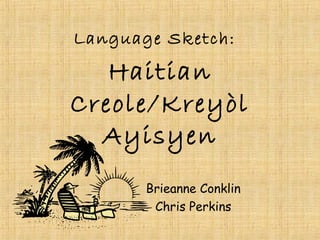Kreyol
- 2. Map
- 3. Introduction ŌĆó Official name: Krey├▓l ŌĆó Creole classification ŌĆó Population of over 7 million
- 4. Related Languages ŌĆó French (regional and colloquial varieties from 17th and 18th centuries) ŌĆó African language influence ŌĆō Kwa group of West Africa ŌĆō Bantu languages of Central Africa ŌĆó Minimal Amerindian language influence ŌĆō Haiti (Ayiti)ŌĆöArawak or Carib meaning ŌĆśvast land of mountainsŌĆÖ ŌĆō Only very few lexical influences
- 5. Sociolinguistic Background Settlement History ŌĆó Very small aboriginal survival of Spanish rule ŌĆó ~1625 Europeans (French), along with a few African slaves began to settle the area ŌĆó 1664 Louis XIV claimed the West of the island ŌĆó Growth of slave population due to indigo, coffee, sugarcane, tobacco, cotton and cacao industry. ŌĆō Led to classic plantation colony with distinctive Creole culture and Creole language ŌĆó 1697 Spanish recognition of French claim to Saint- Dominigue (Haiti)
- 6. Sociolinguistic Background Settlement History ŌĆó Slave population ŌĆō 1681~2,000 (approx. 1/3 of total pop.) ŌĆō 1791~700,000 (approx. 92% of total pop.) ŌĆó Haiti became richest French colony providing 1/3 of French foreign trade ŌĆó Struggle for independence had already begun which succeeded in 1803
- 7. Sociolinguistic Background Sociolinguistic Variation ŌĆó Official languages: French and Haitian Creole ŌĆó All Haitians speak Haitian Creole, but only 10% are considered bilingual in French and H.C. ŌĆó Fluency in French carries higher status Traditional Uses ŌĆó Haitian used in everyday interactions ŌĆó French used in schools, government, official documents, etc. ŌĆó Not allowed to be used for instruction and education until 1979
- 8. Basic Word Order ŌĆó Follows SVO word order typical of French ŌĆó Passive structure takes on common S- Aux-V-O ŌĆó Only questions divert from French using SVO+rising intonation exclusively
- 9. Morphology
- 11. Phonological Features ŌĆó Regional variation makes it difficult to standardize a a phonological description... ŌĆó General phonology similar to French ŌĆó 17 consonants (Hall 1953): Bilabial/ Labiodental Dental Palatal or Velar Plosive p b t d k g Fricative or Sibilant f v s z ┼Ī ┼Š Nasal m n ┼ŗ Lateral l Spirant r
- 12. Phonological Features (ContŌĆÖd) Vowels Front Back Close i u e o čö ├▓ Open a Other Vowels: [an] manman [čön] bčönyčön [wi] uit
- 13. Phonological Features (contŌĆÖd) Determiners ŌĆó Unlike French, determiners do not reflect gender ŌĆó Instead, there are several alternants of the determiner /la/: la ~ a ~ an ~ lan ~ nan ŌĆó Form is selected based on phonological environment
- 14. Syntactic Features Determiners and possessive pronouns occur after the noun: poul ki kouvri pitit li ak-z├©l li chicken REL cover little 3sg with wing 3sg ŌĆśa hen covering her chickens with her wingsŌĆÖ (Arends et al) d├®ni├® vwayaj la last trip DET ŌĆśthe last tripŌĆÖ (Hall 1953)
- 15. Syntactic Features Personal Pronouns: mwen 1sg nou 1pl & 2pl ou 2sg yo 3pl li 3sg ŌĆó No gender distinction ŌĆó No distinction between 1st person plural & 2nd person plural ŌĆó Used for subject and object
- 16. Syntactic Features (contŌĆÖd) ŌĆó Present tense ŌĆ£to beŌĆØ verb not used Li malad / Li nan jaden an 3sg sick / 3sg in garden DET ŌĆśHe is sickŌĆÖ / ŌĆśHe is in the gardenŌĆÖ ŌĆó Markers used for other tenses Li te malad / Li te anba tab la 3sg was sick / 3sg was under table DET ŌĆśHe was sickŌĆÖ / ŌĆśHe was under the tableŌĆÖ (DeGraff)
- 17. Syntactic Features (contŌĆÖd) Negation ŌĆó French negation: ŌĆ£ne ...(verb)... pasŌĆØ ŌĆó Haitian Creole retains ŌĆśpaŌĆÖ in negation; however, it functions more like the French ŌĆ£neŌĆØ H.C. Li pa jam tro ta pou chien anraje 3sg NEG ever too late for dog go mad (Arends et al) French Ce nŌĆÖ est jamais trop tard pour un chien enrager It NEG is never too late for a dog to go mad ŌĆśItŌĆÖs never too late for a dog to go madŌĆÖ
- 18. Sources Arends, J. et al. (1995). Pidgins and Creoles: An Introduction. Amsterdam: John Benjamins. DeGraff, Michel. Comparativ e Creole Syntax. London, U.K. Westminster Creolistics Series, Battlebridge Publications --Morphology in Creole genesis: Linguistics and ideology. (2001). Cambridge, MA: MIT Press. Haitians: Their History and Culture. http://www.culturalorientation.net/haiti Hall, R.A. (1953). Haitian Creole: Grammar, Texts, Vocabulary. Menasha, Wisconsin: American Anthropological Association.












![Phonological Features
(ContŌĆÖd)
Vowels
Front Back
Close i u
e o
čö ├▓
Open a
Other Vowels:
[an] manman
[čön] bčönyčön
[wi] uit](https://image.slidesharecdn.com/kreyol-130501155435-phpapp02/85/Kreyol-12-320.jpg)





